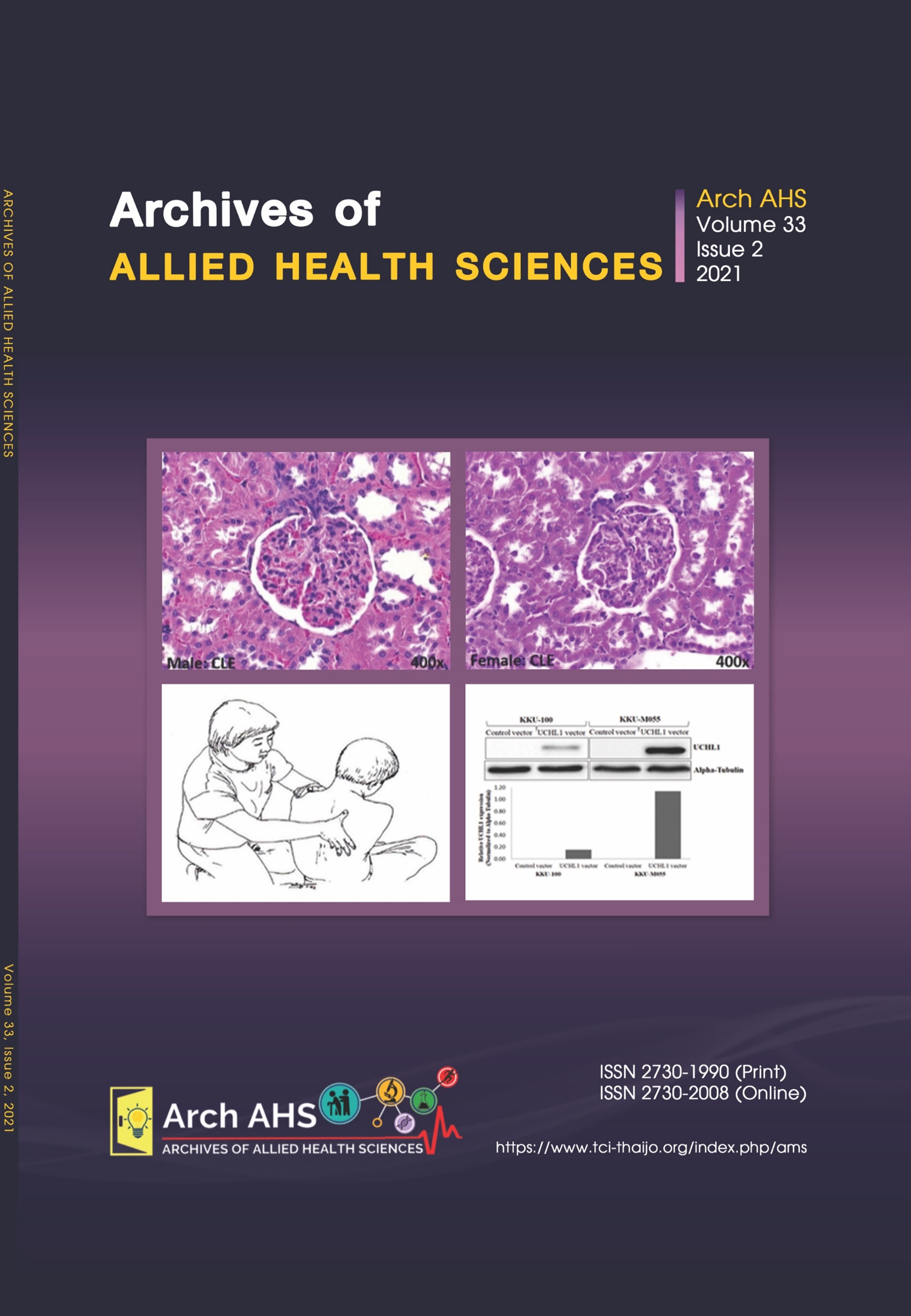Toxicity screening to human peripheral blood mononuclear cells and Wistar rats by Crocodylus siamensisliver extracts
Main Article Content
Abstract
Crocodile organs have been used as ingredients in traditional medicine in Asia for prevention and treatment of diseases. This study, Crocodylus siamensis liver was extracted to evaluate cytotoxicity and immune responses in Wistar rats. The soluble proteins part of C. siamensis’ liver was prepared. In vitro cytotoxicity was assayed in human peripheral blood mononuclear cells (hPBMCs). In vivo chronic toxicity test was performed on Wistar rats with single dose. Body weights, serum biochemical parameters, serum cytokines and the histopathology were observed. The 50% cytotoxic concentration (CC50) of Crude Liver crocodile Extract (CLE) is 28.41 mg/ml. Oral administration showed no toxicity and no adverse effects for chronic period. Serum cytokines did not differ significantly between Th1 and Th2. We found the CC50 of the CLE in hPBMCs. No toxicity was observed in vivo at the study concentration, with the pro-inflammatory cytokines skewed. Since the using of traditional medicine as an alternative therapy is becoming more widely available, this study is an important beginning step to determine the toxicity of bioactive substances which found non-toxic to cells and animal model. For further study, the effectiveness of a biomolecule is compulsorily to identify. To research on their property and develop to supplement products.
Article Details

This work is licensed under a Creative Commons Attribution-NonCommercial-NoDerivatives 4.0 International License.
References
Da Nóbrega Alves RR, Da Silva Vieira WL, Santana GG. Reptiles used in traditional folk medicine: conservation implications. Biodiversity and Conservation 2008; 17(8): 2037-49.
Sodeinde OA, Soewu DA. Pilot study of the traditional medicine trade in Nigeria. TRAFFIC Bull 1999; 18(1): 35-40.
Li HL, Chen LP, Hu YH, Qin Y, Liang G, Xiong YX, et al. Crocodile oil enhances cutaneous burn wound healing and reduces scar formation in rats. Acad Emerg Med 2012; 19(3): 265-73.
Buthelezi S, Southway C, Govinden U, Bodenstein J, du Toit K. An investigation of the antimicrobial and anti-inflammatory activities of crocodile oil. J Ethnopharmacol 2012; 143(1): 325-30.
Chui CH, Wong RSM, Cheng GYM, Lau FY, Kok SHL, Cheng CH, et al. Antiproliferative ability of a combination regimen of crocodile egg extract, wild radix ginseng and natural Ganoderma lucidum on acute myelogenous leukemia. Oncol Rep 2006; 16(6): 1313-6.
Liu Z-W, Shu J, Tu J-Y, Zhang C-H, Hong J. Liver in the Chinese and western medicine. Integr Med Int 2017; 4: 39-45.
Pegg AE, Roberfroid M, von Bahr C, Foote RS, Mitra S, Bresil H, et al. Removal of O6-methylguanine from DNA by human liver fractions. Proc Natl Acad Sci USA. 1982; 79(17): 5162-5.
Nigam A. Lab manual in biochemistry, immunology and biotechnology. New Delhi: Tata McGraw-Hill Education; 2007.
Heo YJ, Son CH, Chung JS, Park YS, Son JH. The cryopreservation of high concentrated PBMC for dendritic cell (DC)-based cancer immunotherapy. Cryobiology 2009; 58(2): 203-9.
Twentyman PR, Luscombe M. A study of some variables in a tetrazolium dye (MTT) based assay for cell growth and chemosensitivity. Br J Cancer 1987; 56(3): 279-85.
Ahmed A, Al Tamimi DM, Isab AA, Alkhawajah AMM, Shawarby MA. Histological Changes in Kidney and Liver of Rats Due to Gold (III) Compound [Au(en)Cl2]Cl. Renal and Hepatic Toxicity of a Gold (III) Compound 2012; 7(12): e51889.
Chen S, Mukoyama T, Sato N, Yamagata S-I, Arai Y, Satoh N, et al. Induction of nephrotoxic serum nephritis in inbred mice and suppressive effect of colchicine on the development of this nephritis. Pharmacol Res 2002; 45(4): 319-24.
Zheng Z, Schmidt-Ott KM, Chua S, Foster KA, Frankel RZ, Pavlidis P, et al. A Mendelian locus on chromosome 16 determines susceptibility to doxorubicin nephropathy in the mouse. Proc Natl Acad Sci U S A 2005; 102(7): 2502-7.
Kleiner DE, Brunt EM, Van Natta M, Behling C, Contos MJ, Cummings OW, et al. Design and validation of a histological scoring system for nonalcoholic fatty liver disease. Hepatology 2005; 41(6): 1313-21.
Nieman WA, Leslie AJ, Wilkinson A. Traditional medicinal animal use by Xhosa and Sotho communities in the Western Cape Province, South Africa. J Ethnobiol Ethnomed 2019; 15(34): 1-14.
Gauthier SF, Pouliot Y, Saint-Sauveur D. Immunomodulatory peptides obtained by the enzymatic hydrolysis of whey proteins. Int Dairy J 2006; 16(11): 1315-23.
River C. Baseline hematology and clinical chemistry values for charles river wistar rats [Crl:(WI)BR] as a function of sex and age. Wilmington: Charles River Laboratories; 1998.
Iribarren C, Jacobs DR, Sidney S, Claxton AJ, Feingold KR. Cohort study of serum total cholesterol and in-hospital incidence of infectious diseases. Epidemiol Infect 1998; 121(2): 335-47.
Tall AR, Yvan-Charvet L. Cholesterol, inflammation and innate immunity. Nat Rev Immunol 2015; 15(2): 104-16.
Kidd P. Th1/Th2 Balance: the hypothesis, its limitations, and implications for health and disease. Altern Med Rev 2003; 8(3): 223-46.


